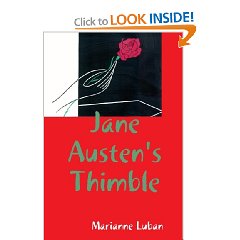 While almost nothing of the vast treasure that must have been buried with the great warrior pharaoh, Thutmose III, survives except some items left on his mummy, three of his concubines fared much better. Their names are obviously foreign, probably West-Semitic, and are usually written as Menhet, Menwi, and Merti. They ended up in my mystery novel, "The Pharaoh's Barber" and I made them sisters, although their true relationship is unknown. I also gave them the formal Semitic names of Marta, Menukhah and Manahet and the last two do seem to correspond to the nicknames given them in antiquity. These foreign girls were buried in a rock cut tomb in what is known as the Wady Gabbanat el-Qurud, discovered in 1916 by Herbert Winlock. The tomb had already been robbed but some of the looted artifacts were recovered and the collection is now in the Metropolitan Museum, New York. Above is a diadem bearing the gazelle heads commonly worn by secondary wives or concubines instead of uraei. Only such golden objects and those made of stone survived as damp had gotten into the tomb and disintegrated the wood and, most unfortunately, the mummies. Winlock thought the women had probably all died at the same time, possibly of a pestilence, and that is their fate in my book. Before that, however, Marta, a very clever and beautiful girl, does a great service to her lord, Menkheperre Thutmose. Here is an excerpt, describing the girls' first meeting with the great man, as viewed by the pharaoh's young barber:
While almost nothing of the vast treasure that must have been buried with the great warrior pharaoh, Thutmose III, survives except some items left on his mummy, three of his concubines fared much better. Their names are obviously foreign, probably West-Semitic, and are usually written as Menhet, Menwi, and Merti. They ended up in my mystery novel, "The Pharaoh's Barber" and I made them sisters, although their true relationship is unknown. I also gave them the formal Semitic names of Marta, Menukhah and Manahet and the last two do seem to correspond to the nicknames given them in antiquity. These foreign girls were buried in a rock cut tomb in what is known as the Wady Gabbanat el-Qurud, discovered in 1916 by Herbert Winlock. The tomb had already been robbed but some of the looted artifacts were recovered and the collection is now in the Metropolitan Museum, New York. Above is a diadem bearing the gazelle heads commonly worn by secondary wives or concubines instead of uraei. Only such golden objects and those made of stone survived as damp had gotten into the tomb and disintegrated the wood and, most unfortunately, the mummies. Winlock thought the women had probably all died at the same time, possibly of a pestilence, and that is their fate in my book. Before that, however, Marta, a very clever and beautiful girl, does a great service to her lord, Menkheperre Thutmose. Here is an excerpt, describing the girls' first meeting with the great man, as viewed by the pharaoh's young barber:"The Canaanite wives wore their colorful, embroidered dresses they had brought from home but they also had some beautiful golden things upon their heads and all kinds of jewelry on their necks, wrists and ankles. Each one had a little ring in her nostril. Their eyes were painted like the Egyptian wives, but not so much, and they were lacking reddened lips and cheeks. But their own blood in their cheeks gave them the blush of roses. Instead of sandals, the sisters wore on their feet small shoes of yellow leather. Levi was glad to see that the scorned sisters confronted the pharaoh, whom they did not know at all, bravely, and held their thin, arched noses proudly before them."
By the way, the person doing the observing was not born in Egypt but in Asia. Probably, he had never seen the kind of flower we westerners call a rose, but he had surely seen rock roses, which look like this:
Although my book is not really geared toward young adults, it begins where my favorite teenage novel, "Mara, daughter of the Nile", by E. J. McGraw, left off. I am as convinced as McGraw that Hatshepsut was not a nice lady. Ultimately, these wives must have come to mean something to the king because they were given a sumptuous burial, including the wonderful jewelry that can be seen today.









No comments:
Post a Comment